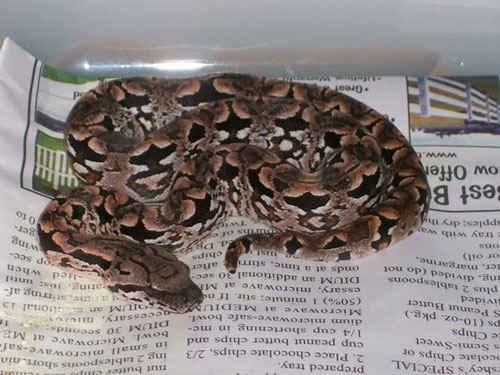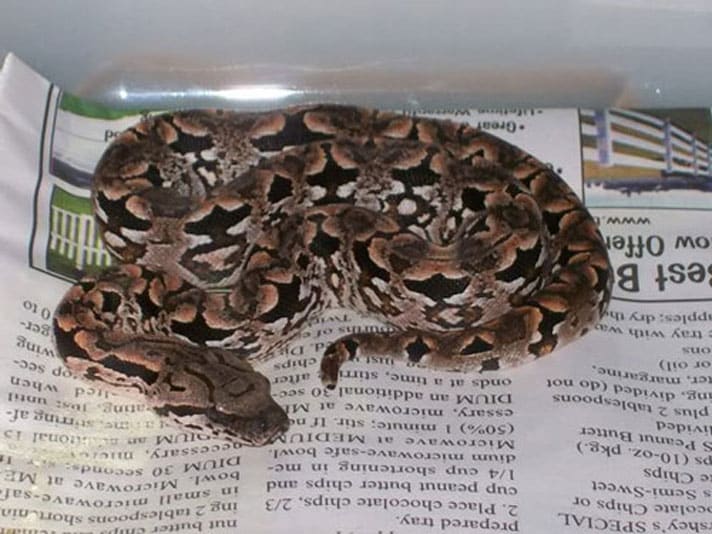Expert tips on breeding the Dumeril's Boa
There are a lot of different opinions on the degree of difficulty of breeding Dumeril’s boas (Boa dumerili). My first success with Dumeril’s boas was almost accidental. They are not difficult to breed. If a male Dumeril’s boa is housed with one or more female Dumeril’s boas at all times, the male will attempt to breed year round. That doesn’t mean that babies will be born. I recommend keeping your Dumeril’s boa pairs separate and introducing them during breeding season. Dumeril’s boas reach sexual maturity between an age of 3 and 5 years old. I prefer my breeders to be at least 4 years old before I attempt to breed them.
Dumeril’s boas require a brumation period for breeding. Start cooling your snakes in late October to early November. Gradually drop daytime temperatures under the hotspot to around 80 degrees Fahrenheit over several weeks, and turn the heat source off at night. I recommend using an appliance timer to help control your heat cycle. In my Dumeril’s boas, I’ve noticed that the heaviest breeding activity occurs during the cooling period.
Begin warming your Dumeril’s boas back up around late January to early February. Gradually raise the temperatures over a couple of weeks, and leave the heat source on at night. Cool-end temperatures should be returned to 75 to 80 degrees Fahrenheit, and warm end temperatures to around 85 degrees.
As with most snakes, a female Dumeril’s boa will have a noticeable lump in her belly during ovulation. This can happen in either the cool-down or warm-up period. This is contradictory to most snake species, where you only see it in the warm-up period, but I have found Dumeril’s boas to be different. It is still OK to leave your male Dumeril’s boa in the enclosure beyond this point because you cannot be certain he has successfully mated with her. I recommend pulling the males from the female’s enclosure around the beginning of March. Most snake keepers stop feeding other species during a breeding cycling, but Dumeril’s boas can and will continue to eat during this time.
A female’s gestation period can last up to nine months. However, if breeding was successful, you should usually see babies around mid- to late-August on into September, and sometimes as late as October or November. Female Dumeril’s boas will continue eating during this time. I offer smaller-than-normal food items, so as to avoid digestion issues. For example, if you usually feed your females large rats, feed them small rats during gestation, at intervals of every 15 to 20 days.

Photo by Pat Higdon
Dumeril’s boas reach sexual maturity between an age of 3 and 5 years old, but the author prefers to wait until they are at least 4 years old before breeding them.
It is hard to predict when these live-bearers will give birth. Some signs that a female Dumeril’s boa is gravid are: lying inverted on or under a heat source, lying with the rear third of the body on or under a heat source, and turning a darker color in an effort to absorb more heat during gestation. Female Dumeril’s boas will generally give birth, anywhere from one day to two or three weeks following the pre-birth shed.
When you are certain that your female Dumeril’s boa is near birthing or has had her pre-birthing shed, I highly recommend moving her to a separate enclosure. You can also do this after you are certain successful ovulation has occurred. It has been my personal experience that male Dumeril’s boas can attack and kill females that are near birthing. It is not certain what triggers this reaction, but take caution if you notice a male acting nervously or aggressively around a female. Moving her will also allow you to closely monitor the birthing process, and if you have been keeping two female Dumeril’s boas together, separating them will help you be certain which female is giving birth.
Caring for Hatchling Dumeril's Boa Constrictors
After the female Dumeril’s boa gives birth, remove her from the birthing enclosure just to make sure the neonates are safe. Neonate Dumeril’s boas should be removed from the birthing enclosure once they have absorbed their yolk sac. Some neonates are even born with their yolk sacs all ready absorbed. However, if they still have their yolk sac, it is best not to move a neonate until the yolk sac is completely absorbed, doing so could lead to health issues or death. Neonate Dumeril’s boas can be housed in a shoebox style rack or in a 5- to 10-gallon glass terrarium. Do not house neonate Dumeril’s boas together, cannibalism has been documented among litter mates. Offer a moist paper towel or newspaper substrate, a water bowl and a dark hide. Temperatures are the same as mentioned for adult Dumeril’s boas.
First shed will occur within the first seven to 10 days, but some Dumeril’s boas will even shed right after being born. Following yolk sac absorption and the first shed, offer your neonate Dumeril’s boa a live pink rat or small fuzzy rat as a first meal. You can try a thawed frozen food item, but don’t be surprised if the snake won’t eat. If your neonate does not feed at this time, wait a day or two and try again. I have had my best luck getting neonate Dumeril’s boas to feed by placing a dark towel over the feeding enclosure, thus offering a little privacy and making them feel secure.
Sexing neonate Dumeril’s boas is tricky. Popping or probing methods can be used, but they are not very reliable. The most reliable method is to check for spurs. Male Dumeril’s boas will have a small spur on either side of the cloaca and females will not. I have had a 90-percent success rate in sexing my neonate Dumeril’s boas with this method.
A Look Ahead at Dumeril's Boas
There seems to be a trend in herpetoculture lately where the popularity of a species is based on color and pattern morphs. In the past, there have been no proven genetic morphs for Dumeril’s boas. In the last few years, this has changed. There is a proven line T-plus albino Dumeril’s boas (also known as caramel Dumeril’s boas) being developed in Germany. Babies have been produced but are not yet available. There are also a small number of hypomelanistic Dumeril’s boas being bred in the United States and in Europe, as well as a line of what is being called “orange glow” Dumeril’s boas being developed in the U.S. Only time will tell if these conditions are going to be proven genetic. Some breeders are currently breeding animals for color, as can be seen in the high-red Dumeril’s boas.
Will the popularity of these snakes ever rival that of ball pythons? The future of the Dumeril’s boa is literally in the hands of a small group of dedicated and passionate breeders. Hopefully, I have intrigued a few more people to think about the often overlooked, Dumeril’s boa.



